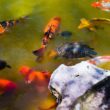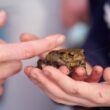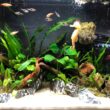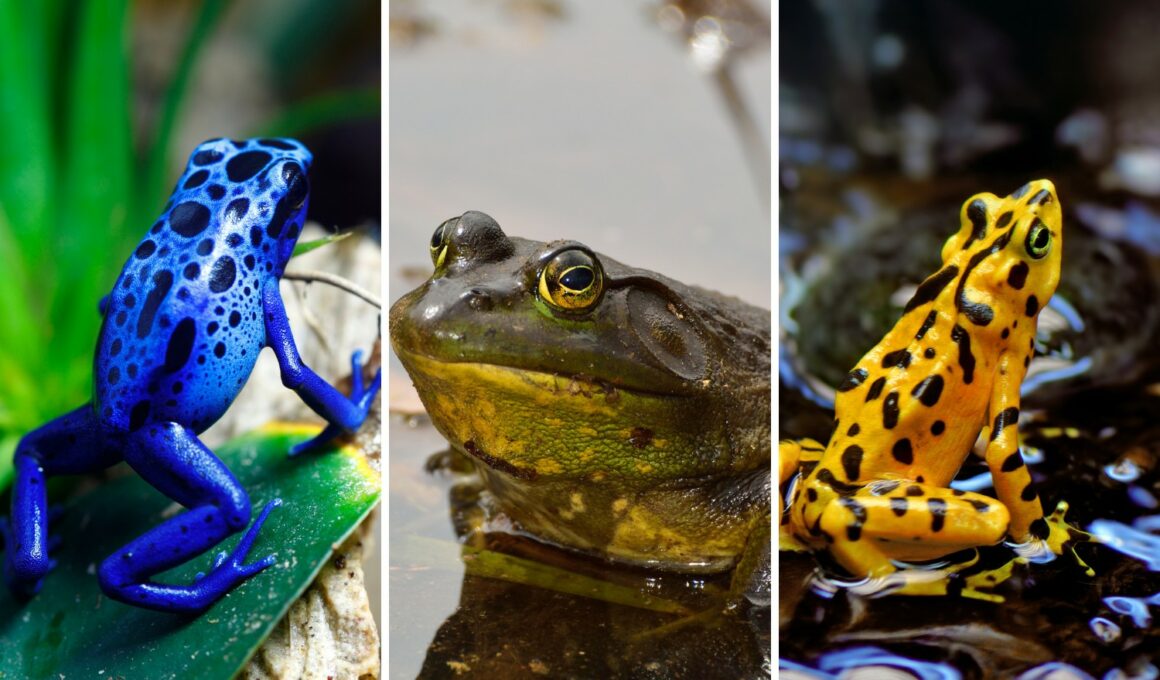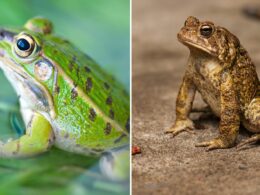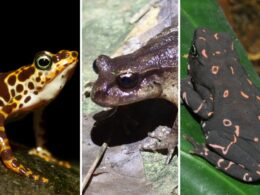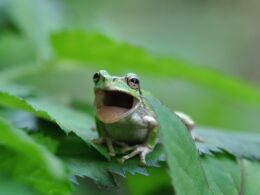In this article Show
When I’m not busy tending to my beloved pets, you can often find me buried in a book or scrolling online, diving deep into the fascinating world of reptiles and amphibians.
Frogs, in particular, have always held a special place in my heart. And if you’ve ever taken a moment to appreciate the array of colors and patterns these little creatures boast, you’d understand why.
Now, I’m sure many of you have seen or heard of the classic green frog. But did you know that our planet is home to frogs that shimmer in gold, dazzle in electric blues, and even ones that seem to have borrowed their hues straight from a rainbow? The variety is mind-boggling!
Colors in the frog world aren’t just about looking pretty. They play crucial roles in survival, attracting mates, and even sending out deadly warnings. Think of them as nature’s little billboards, each color sending out its unique message.
So, whether you’re a seasoned herpetologist or just someone with a budding interest, join me on this vibrant journey as we hop through the list of the top 10 most colorful frogs in the world. Trust me; it’s going to be a visual treat!
The Role of Colors in Frog’s Life
Alright, so before we jump into our vibrant list, let’s get a tad bit scientific (but not too much, I promise) and understand why some frogs look like they’ve been painted by Picasso while others seem to blend seamlessly with their surroundings.
1. Warning to Predators (Aposematic Coloration)
Ever seen a frog that looks like it was just dipped in neon paint and wondered, “Why so flashy?” Well, that’s Mother Nature’s way of saying, “Stay away!” Many of these brilliantly colored frogs are toxic, and their vibrant hues are a warning sign to predators.
This is known as aposematic coloration. It’s like a frog’s way of saying, “Eat me, and you’ll regret it.” And trust me, with some of these frogs carrying enough poison to knock down a few grown humans, those predators better pay heed!
2. Mating Signals and Territory Claims
It’s not always about danger, though. Sometimes it’s about love. During the mating season, male frogs often show off their colors to attract a mate. Think of it as their version of dressing up for a date.
A brightly colored frog can signal good health and vitality, which is quite attractive in the frog world. Plus, these colors can also play a role in territory disputes. A bold display of colors can deter rival males, kind of like saying, “This pond’s taken, buddy!”
3. Camouflage and Environmental Blending
On the other end of the spectrum, many frogs aren’t about standing out. They’re masters of disguise. Their colors and patterns help them blend seamlessly with their surroundings, be it on a leaf, a tree bark, or the forest floor.
This type of camouflage is essential for these frogs to hide from predators. It’s their way of saying, “Nothing to see here, move along.” And the effectiveness of this camouflage is truly remarkable – you might be looking right at one and not even realize it!
So, as you can see, when it comes to frogs, colors are much more than skin-deep. They’re a language, a tool, and sometimes, a lifeline. With that newfound appreciation, let’s hop into our list of the most colorful frogs, shall we?
Top 10 Most Colorful Frogs
As promised, here’s our mesmerizing list. I wish I could show you these frogs in person because words (and even photos) sometimes don’t do justice to their real-life brilliance. But alas, for now, we’ll have to rely on high-quality images and vivid descriptions. So, brace yourself for a kaleidoscopic journey!
1. Golden Poison Dart Frog
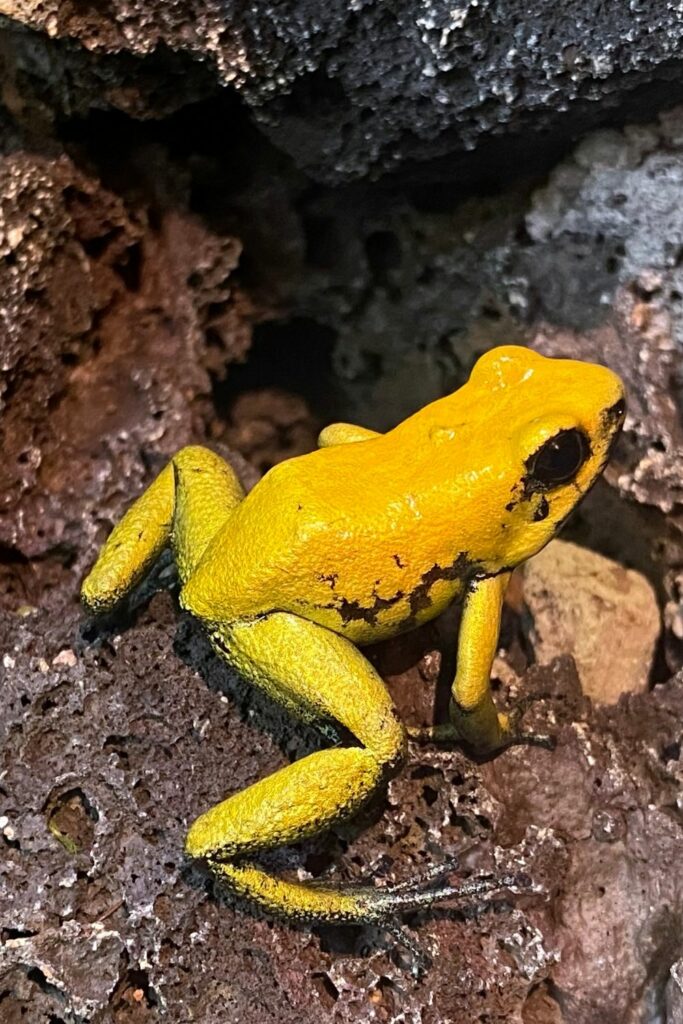
Habitat
The dense, humid rainforests of the Pacific coast of Colombia.
Description
This small frog, often no larger than a paper clip, is a sight to behold with its intense, gleaming yellow skin. But don’t let its beauty fool you. The Golden Poison Dart Frog is named so for a reason. It’s one of the most toxic animals on Earth.
The indigenous Emberá people of Colombia have historically used its powerful toxins to poison the tips of their blow darts (hence the name).
One frog carries enough poison to harm up to 20 humans or 2 African elephants. So, as much as you might be tempted, it’s best to admire this one from a distance.
2. Red-Eyed Tree Frog
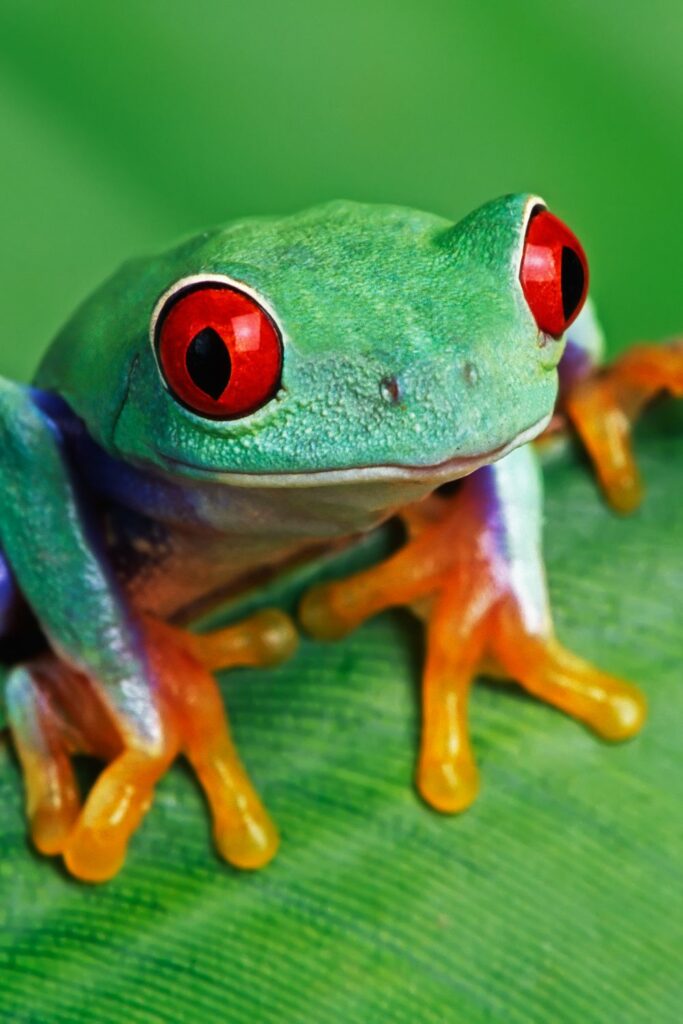
Habitat
Lowland tropical rainforests in Central America, stretching from Mexico to Colombia.
Description
The Red-Eyed Tree Frog is the poster child for tropical frogs, and it’s easy to see why. With its vibrant green body, blue streaks, orange feet, and, of course, those iconic crimson eyes, it looks like something straight out of a fairy tale.
While these bright colors might make you think they’re out to warn predators, these frogs are non-toxic.
The shocking red eyes, when opened suddenly, may startle predators, giving the frog a split second to leap to safety. They’re nature’s version of a flash mob but for self-defense!
3. Blue Poison Dart Frog
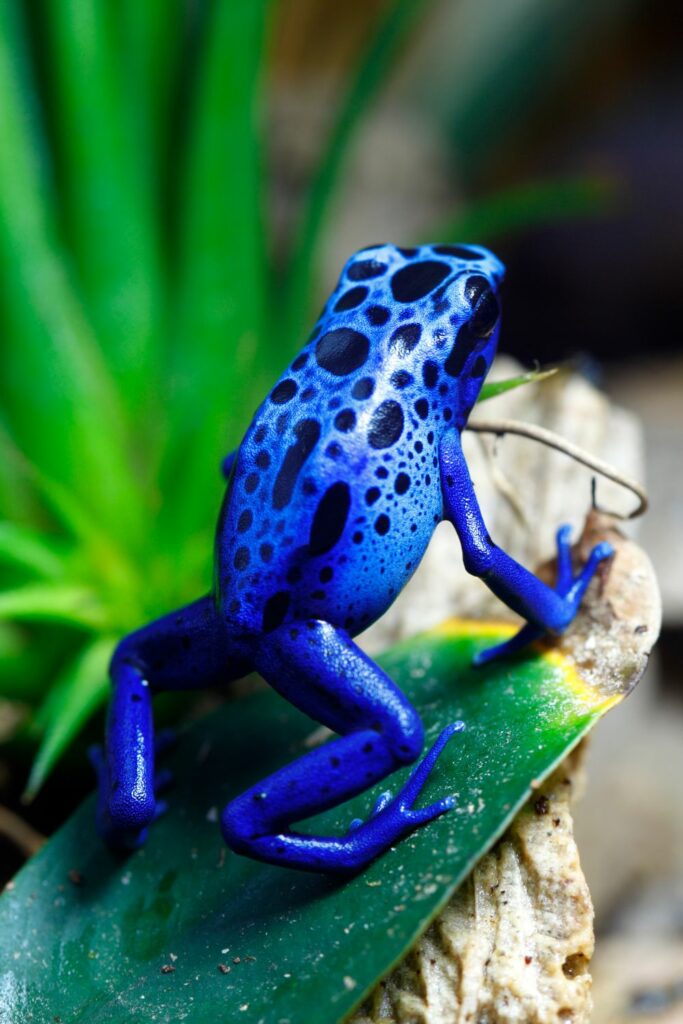
Habitat
Rainforests of southern Suriname and adjacent far northern Brazil.
Description
Sporting a shade of blue that would make the sky envious, the Blue Poison Dart Frog is a living gem. This radiant amphibian has a background color of azure, cobalt, or indigo, beautifully contrasted with black spots.
Similar to its golden cousin, this frog is also toxic. Indigenous tribes have been known to use their toxins for hunting.
These frogs are relatively small, but they carry an aura that’s larger than life, making them a favorite among herpetologists and enthusiasts alike.
4. Harlequin Toad
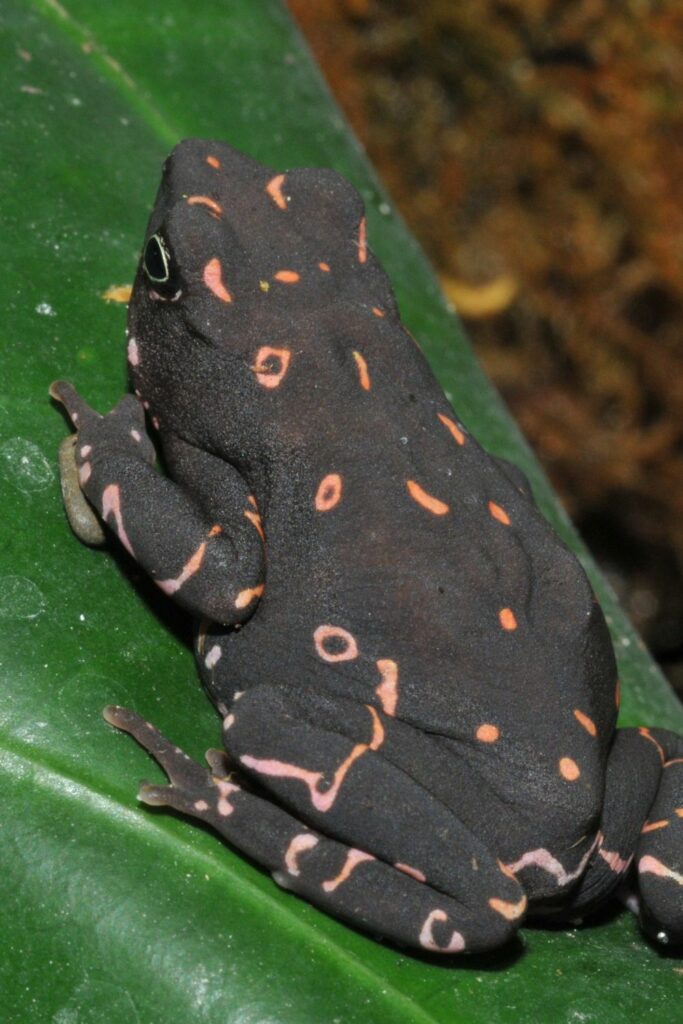
Habitat
Found in the high-altitude streams of the Andes in South America.
Description
Artistry at its best, nature seems to have taken a special liking to the Harlequin Toad. With its mosaic-like patterns and a myriad of vibrant colors ranging from burnt oranges and fiery reds to lush greens and deep blues, it’s a toad that could easily inspire a fashion line.
But while they’re a visual delight, many species of Harlequin Toads are endangered due to habitat loss and disease. It’s a sad irony that one of the most vibrant frogs faces such a dark future.
5. Mantella Frogs
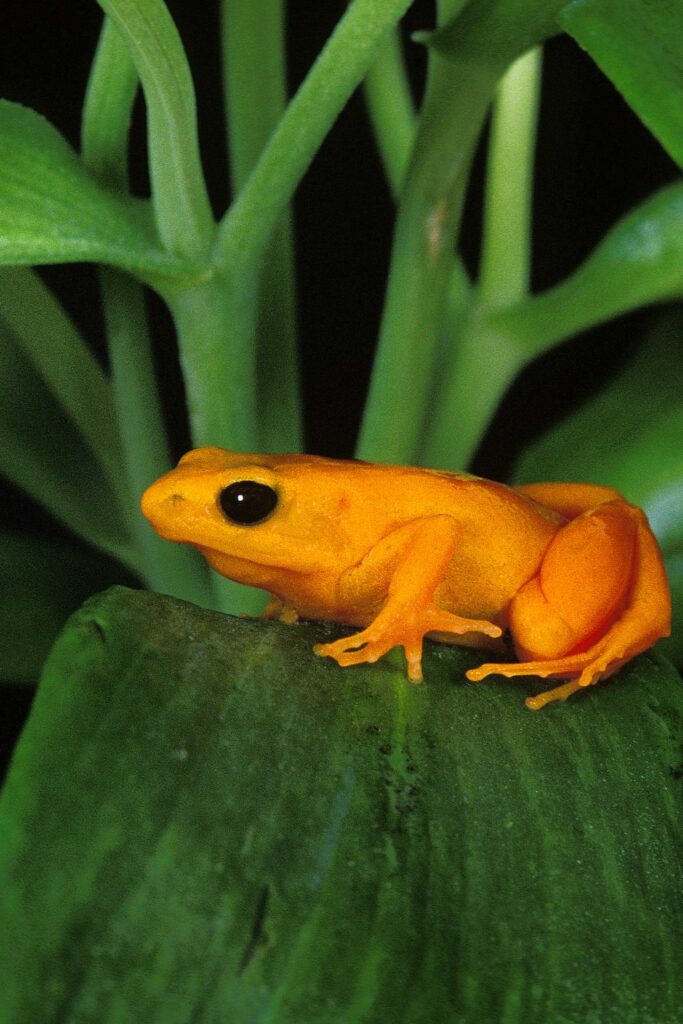
Habitat
The diverse landscapes of Madagascar, from rainforests to swampy areas.
Description
Madagascar isn’t just about lemurs. Meet the Mantella Frogs – nature’s answer to the South American poison dart frogs but with their unique Malagasy twist.
Their bright yellow, orange, and green colors serve as a warning to potential predators about the alkaloid toxins present in their skin.
These petite, diurnal frogs are quite the sight, hopping about during the day, a burst of color against the earthy tones of their homeland.
6. Corroboree Frog
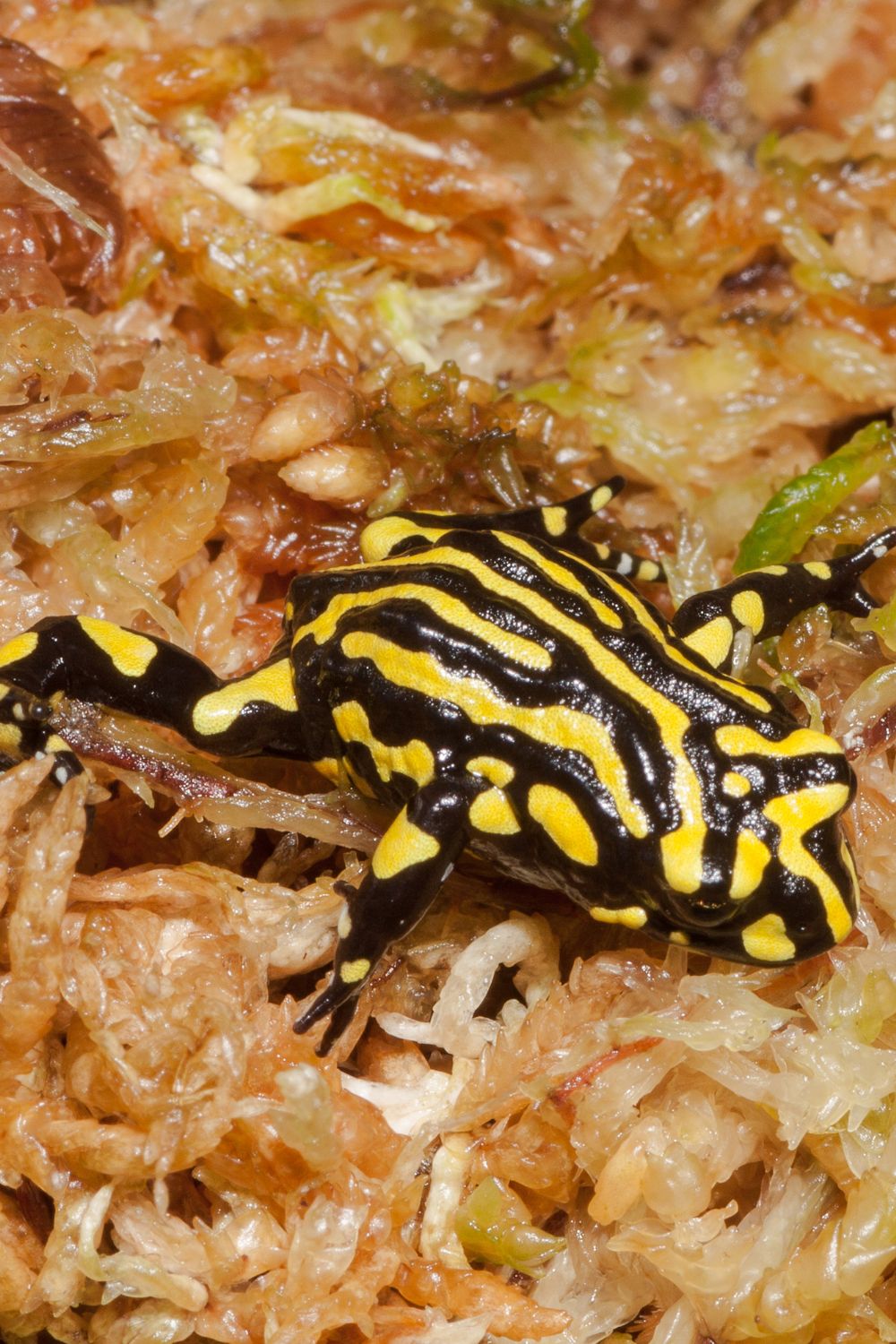
Habitat
Alpine and sub-alpine regions of Australia, especially within the Kosciuszko National Park.
Description
The Corroboree Frog wears its heart on its skin, quite literally. Adorned with striking black and yellow stripes, it resembles a heartbeat monitor’s zigzag.
This pattern isn’t just for show; it’s a visual representation of the frog’s resilience, surviving in cold climates where few other frogs dare to tread.
But as resilient as they might be, these frogs are critically endangered, primarily due to habitat destruction and a deadly amphibian disease.
7. Strawberry Poison Dart Frog
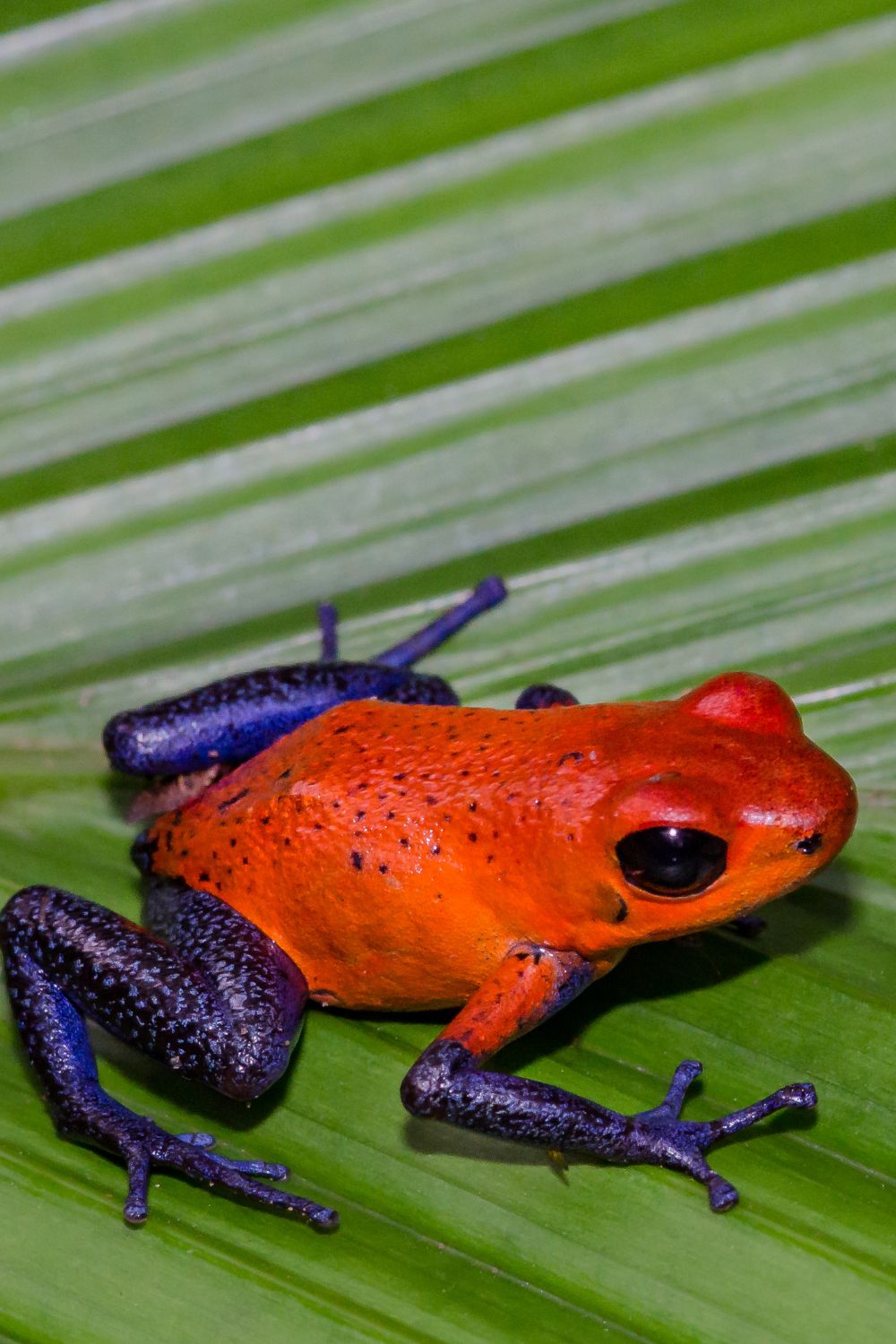
Habitat
Humid lowlands of Central America, from Nicaragua to Panama.
Description
Can a frog be both charming and fierce? The Strawberry Poison Dart Frog answers with a resounding “yes.” Tiny but mighty, these frogs flaunt a delightful mix of reds, blues, and greens, often resembling a ripening strawberry.
While their looks can be deceiving, their skin secretes alkaloid toxins, making them a dangerous treat for any unsuspecting predator. Each individual can look quite different depending on its specific region, making them a captivating study for enthusiasts.
8. Glass Frogs
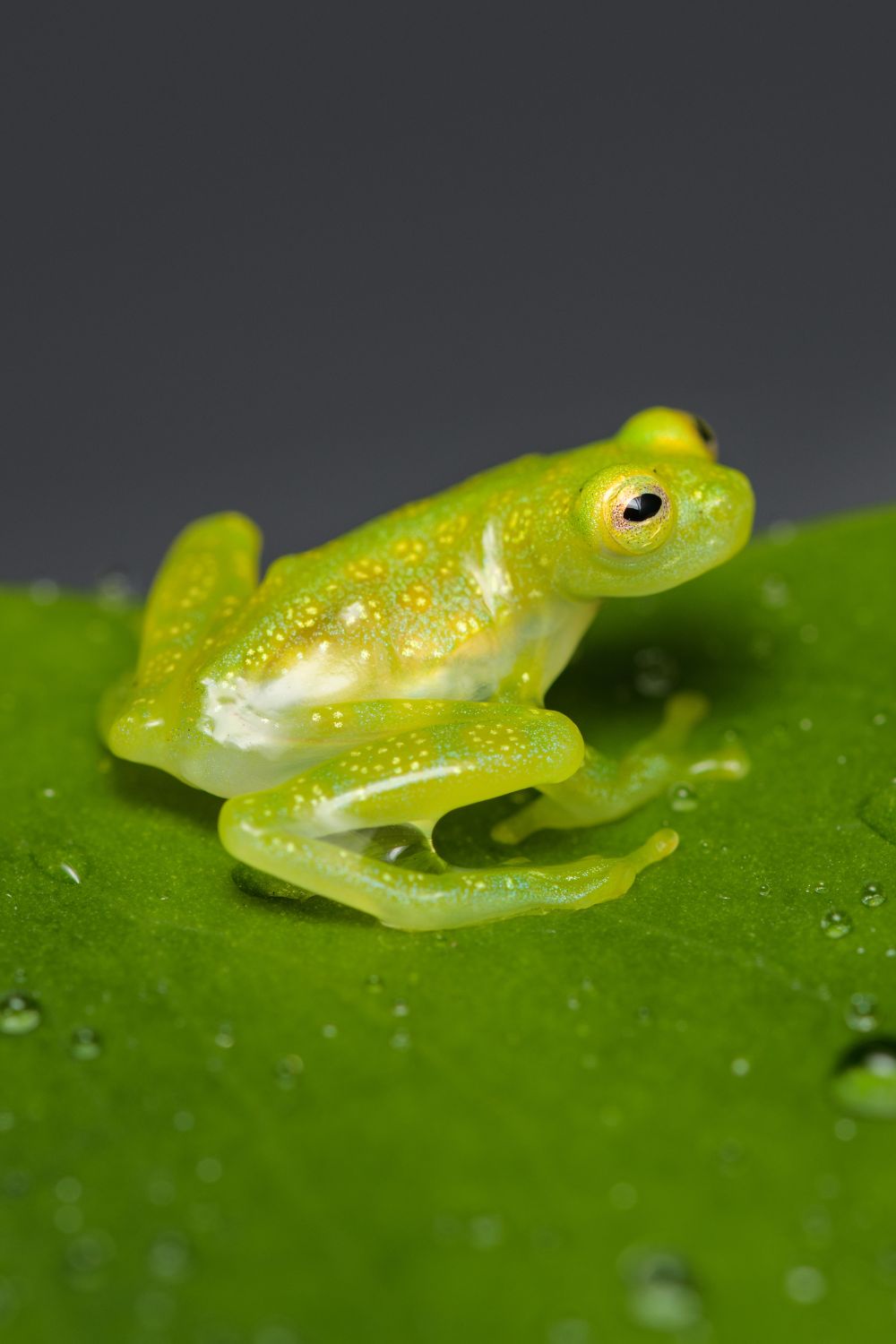
Habitat
Found in the rainforests of Central and South America, often near rivers and streams.
Description
Nature’s X-ray machine, Glass Frogs offers a peek into their world, quite literally. These delicate frogs have semi-transparent skin on their underbellies, revealing their beating hearts, winding intestines, and other internal organs. It’s like an anatomy lesson, sans the lab.
The tops of these frogs are usually a leafy green, allowing them to blend seamlessly with the foliage and go unnoticed by predators. Their translucent undersides are not just for show, but they also play a role in camouflage, making the frog seem even more inconspicuous.
9. Granular Glass Frog
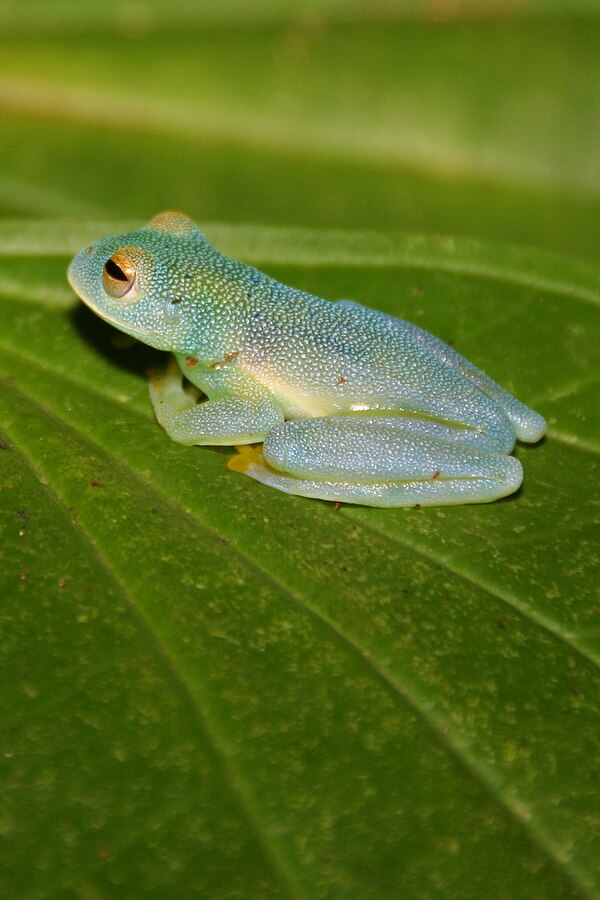
Habitat
Rainforests of Central America, typically around freshwater streams.
Description
A close relative of the Glass Frogs, the Granular Glass Frog gets its name from the granulated texture of its skin. It’s like someone sprinkled a pinch of salt over them.
Combine that with a radiant shade of green, and you’ve got a frog that’s both fascinating and beautiful. Like its relatives, its underbelly offers a clear view of its inner workings, a characteristic that never ceases to amaze.
10. Borneo Rainbow Toad
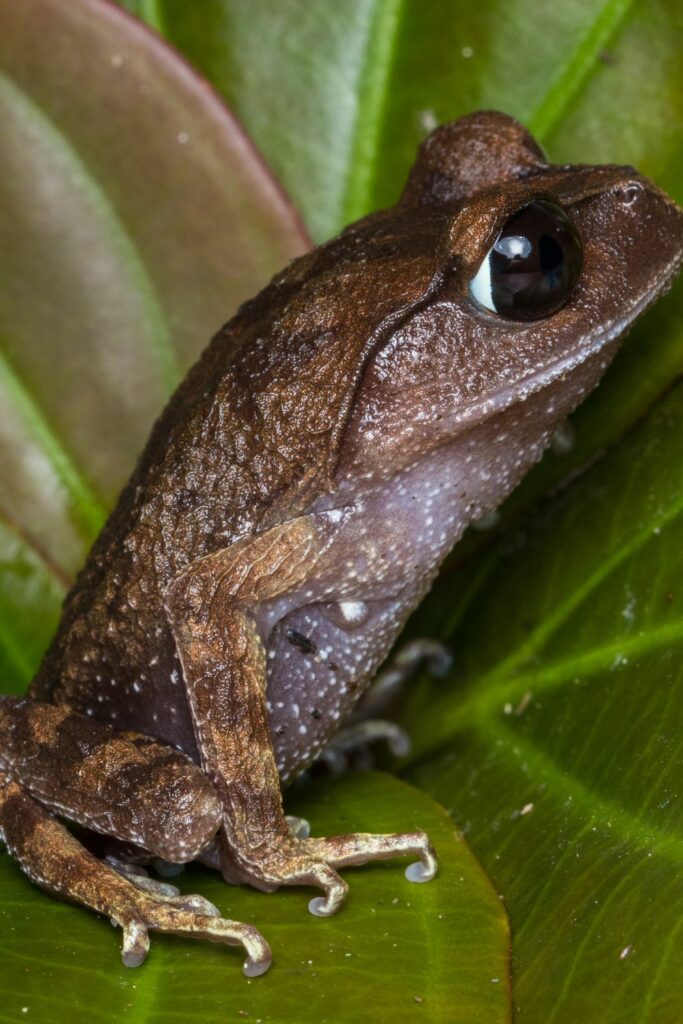
Habitat
The high-elevation forests of Borneo.
Description
The Borneo Rainbow Toad sounds like a mythical creature straight out of a fantasy novel, and honestly, it might as well be. This elusive toad boasts a color palette that ranges from vibrant purples and blues to deep yellows and reds.
It’s like a painter’s dream canvas. However, seeing one in the wild is a rarity. For over 87 years, scientists believed it was extinct until it was rediscovered in 2011. A true testament to nature’s ability to hide her most treasured secrets!
Exploring the vast spectrum of frog colors and patterns feels akin to traveling the world, each species reflecting the uniqueness of its habitat and the evolutionary journey it has undertaken.
These are but ten of the thousands of frog species that grace our planet. But I hope this list gives you a glimpse into the incredible diversity that the amphibian world holds.
Each frog, colorful or not, plays a vital role in the delicate balance of our ecosystems. And as we cherish their beauty, let’s also remember our responsibility to protect them.
Conservation Concerns
As we marvel at the beauty and diversity of these vibrant frogs, it’s essential to recognize the threats they face. Our planet’s amphibians, especially frogs, are undergoing a silent crisis.
Their decline, in many cases, is a grim reminder of the broader challenges in global biodiversity. Let’s delve deeper into some of the pressing concerns:
1. Impact of Habitat Loss on Colorful Frogs
Habitat loss is one of the most significant threats to our vibrant amphibian friends. Whether it’s due to deforestation, urbanization, or agriculture, the places these frogs call home are rapidly shrinking.
Remember the lush rainforests and serene streams we talked about earlier? Many are now fragments of what they once were.
For frogs, it’s not just about losing a home. It’s about the loss of their breeding grounds, their food sources, and their very way of life.
Colorful frogs, like the Borneo Rainbow Toad, are especially vulnerable since many of them have highly specialized habitats. If that specific environment is altered or destroyed, it could mean the end for an entire species.
2. Role of Pet Trade and Other Threats
While it’s tempting to have a piece of the rainforest in our living rooms, the exotic pet trade has serious implications for wild frog populations.
Over-collection for both pets and, sometimes, traditional medicine, can deplete local populations to dangerously low levels.
But that’s not the only man-made threat. Pollution, particularly in the form of pesticides and herbicides, can contaminate the waters these frogs depend on. Then there’s the issue of climate change, which can alter the delicate balance of their ecosystems, making survival even more challenging.
3. Importance of Conservation Efforts
Now, it’s not all doom and gloom. Amidst the challenges, there’s a beacon of hope. Conservation efforts worldwide are making a difference. Protected areas are being established to safeguard these frogs and their habitats. Captive breeding programs are ensuring that even the most endangered species have a fighting chance.
As enthusiasts and admirers of these colorful frogs, we can play our part. Supporting conservation organizations, being responsible pet owners, and raising awareness can go a long way. Remember, every individual effort counts.
In the words of Jane Goodall, “What you do makes a difference, and you have to decide what kind of difference you want to make.”
How to Safely Observe Colorful Frogs in the Wild
Seeing these colorful frogs in pictures and reading about them is one thing, but witnessing their vibrant beauty in the wild? That’s an entirely different and mesmerizing experience.
However, as with any wildlife observation, there are guidelines to ensure the safety of both the observer and the observed. Here’s how to make your frog-watching adventure both memorable and respectful:
1. Respect for Their Habitat
The golden rule of any wildlife observation is to “leave no trace.” This means:
- Stay on Designated Paths: Avoid trampling on sensitive areas, which could be potential breeding grounds or shelters for frogs.
- Avoid Disturbances: Keep noise levels down, and refrain from using flash photography, which could disturb and stress the frogs.
- Pack In, Pack Out: Whatever you bring with you – be it food, water bottles, or any trash – ensure you take it back. A pristine habitat is a thriving habitat.
2. Avoid Touching Due to Toxins
Many colorful frogs, like the Poison Dart Frogs, have earned their names for a reason. Their skin can secrete toxins, which can range from mildly irritating to fatally poisonous.
- Safety First: Even if a frog looks harmless, touching it can be dangerous. It’s always best to observe from a distance.
- For Their Safety Too: Besides the risk of toxins, our hands can transfer oils, lotions, or other chemicals onto the frog’s sensitive skin, which could harm them.
3. Using Guides and Tours for Safe Experiences
If you’re in unfamiliar territory, there’s no substitute for local knowledge.
- Expertise Matters: Local guides or naturalists often have years of experience. They can lead you to the best spots without causing harm to the habitat or the frogs.
- Educational Experience: A knowledgeable guide can share insights about the frogs’ behavior, life cycle, and conservation status, making your observation even more meaningful.
- Support Local Conservation: Often, eco-tours directly benefit local conservation efforts. By opting for guided tours, you’re contributing to the preservation of the very species you’ve come to admire.
Observing colorful frogs in the wild is a privilege. It’s a chance to connect with nature, to understand the delicate balance of ecosystems, and to be reminded of the wonders our planet holds.
With care, respect, and a bit of guidance, it can be an enriching experience that leaves a lasting impact, not just on you, but on the generations of frogs that will continue to hop, croak, and dazzle in their colorful splendor.
Planning a trip or curious about any other wildlife observation tips? Let me know how I can help further!


